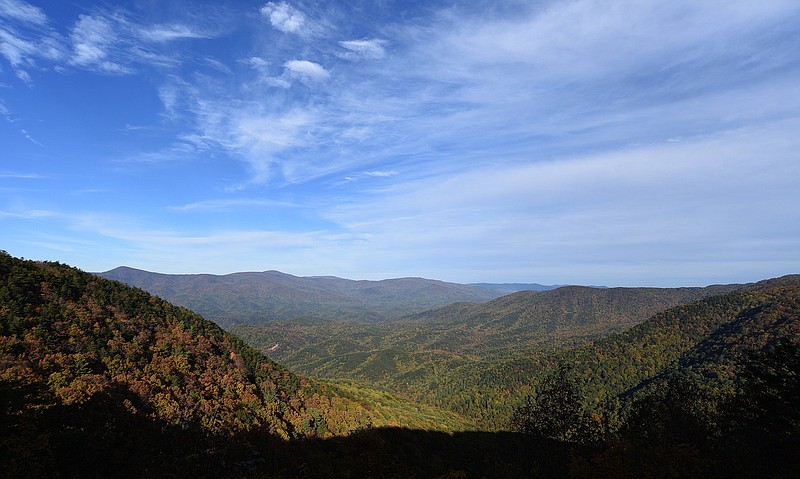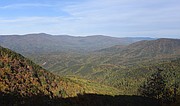The public has less than six weeks to comment on a U.S. Forest Service project twice the size of Atlanta dubbed the Foothills Landscape Project, which aims to conserve more than 5,000 acres of old-growth forest, create small canopy gaps and restore woodland habitat for native species of plants and animals.
The U.S. Forest Service environmental assessment issued for the Foothills Landscape Project has been revised from its original version released in 2019, and it attempts to address a primary complaint that the process lacked for public participation.
Plans still propose a variety of restoration activities to provide "a mosaic of sunlight and shade" and recreation enhancement in various future projects planned across 157,625 acres of federal land within the Conasauga, Blue Ridge and Chattooga River ranger districts of the Chattahoochee-Oconee National Forests, according to the revised, final environmental assessment on the proposed work released Oct. 27.
The Conasauga Ranger District is nearest to Chattanooga, including the project implementation area in Murray, Fannin and Gilmer counties, while most of the project area lies further east in the Blue Ridge and Chattooga River Ranger Districts in Dawson, Habersham, Lumpkin, Rabun and White counties. The Conasauga portion surrounds Georgia's Fort Mountain State Park, east of Chatsworth, but does not include work there.
(READ MORE: Ancient Native American site defaced in Georgia forest)
Chattahoochee-Oconee National Forests Forest Supervisor Edward Hunter said in an emailed statement he was thankful to participants in the process for "helping us achieve this landmark milestone to restore the foothills landscape."
"After five years of tremendous effort and contributions by our local communities, stakeholders, partners and U.S. Forest Service staff, the Foothills Landscape Project is a model for collaboration and provides the opportunity to address critical challenges threatening the forest," Hunter said. "From climate change impacts to exploding public demand for recreation, only together can we ensure we are doing the right work in the right places at the right scale."
People have until Dec. 13 to comment on the project, but under federal laws in place since 2013, objections can only be filed by those who have previously commented during a 30-day public input period held in late 2019, a comment period that drew criticism from conservationists at the time for being too short. Another 30-day comment period was held in July 2021.
The Southern Environmental Law Center has been dubious of the project, but officials are heartened by revisions.
The law center is the largest nonprofit environmental legal advocacy organization in the South and consists of lawyers, experts and community advocates who address issues involving air, water, land, wildlife and people who live in the South's natural settings, according to the organization's website.
"We commend the forest service for listening to public concerns and changing its approach to the Foothills Landscape Project," law center senior attorney Brian Gist said Friday in an emailed statement. Law center officials are still poring over the revisions in the document, and they like some of what they see so far, he said.
"We are still evaluating the final environmental assessment for the project, but are encouraged by its planned use of a phased review of projects," Gist said. "Informed public input is critical to responsible forest management and, if implemented correctly, the phased approach will better allow the people who live near, recreate in, and love this area of the Chattahoochee National Forest to have a voice in the Foothills Landscape Project."
Law center officials will determine whether to file an objection as the December deadline approaches, he said.
The law center criticized the previous version of the project for including what it said was an estimated 60,000 acres of commercial timber harvest, 50,000 acres of prescribed burning, 360 miles of new bulldozer paths for the burning project and an unspecified number of other roads, as well as changes and relocation of trails and campgrounds.
HOW TO COMMENT
To comment on the Foothills Landscape Project:— Mail: Ken Arney, Regional Forester, ATTN: Stephanie Israel, 1755 Cleveland Highway, Gainesville, GA 30501.— Fax: 770-297-3011.— Online: Comment and get project updates at bit.ly/FoothillsLandscape.
Chattahoochee-Oconee National Forests spokesperson Steven Bekkerus said in an email Friday the project plan has changed from "condition-based" to "programmatic," and that public comments led to a different approach, including timbering.
The change was made "so that broader actions may now require further review that can be tiered to this analysis," Bekkerus said. Public notifications will be issued prior to implementation of activities, he said.
"At a minimum, the forest service plans to hold an annual workshop to discuss potential activities expected within the scope, scale and extent of this analysis," Bekkerus said. "These public forums, as well as ongoing communication with the anticipated 'Foothills Collaborative Group,' will be used to identify any unresolved issues and refine subsequent proposals within the scope and scale of this decision.
"If warranted, projects will be publicly scoped and the appropriate level of review carried out if a review of site conditions for those future projects results in new or changed information that differs from what was considered in this analysis," he said.
Regarding previous concerns about timbering, Bekkerus said public comment led to changes there, too.
"The specific acreage of treatments will be based on the ecological needs within a given implementation area but will not exceed the thresholds analyzed in this [environmental assessment]," he said. "Once the areas are defined, there will be another opportunity for the public to review."
According to the assessment, the work would include removing unwanted, non-native trees through timbering but only on land deemed appropriate for the activity and vetted through the public review process. Officials estimate 35,807 acres of the project area are considered unsuitable for timber production while approximately 121,774 acres are considered suitable for timber production, documents state. Some work could be done commercially and other work could be done by federal crews and some actions describe the use of herbicides.
Other work proposed includes road reconstruction to facilitate timbering, raising stream profiles by filling or plugging ditches to improve bogs, removal or thinning of vegetation and trees, use of prescribed burning to remove unwanted vegetation and prepare the ground for planting, extensive efforts to restore southern yellow pine stands and reconstruction of roads to widen curves and address public access issues. Some campgrounds are listed for potential decommissioning along with some trails used by hikers and off-road vehicles.
(READ MORE: Local conservation group critical of 133-acre Prentice Cooper timber sale)
The project's "collaborative group" is a work in progress and will help guide the project, Bekkerus said.
"Presently, a group of volunteers who represent a variety of interests and organizations (including representatives from Georgia Department of Natural Resources, U.S. Fish & Wildlife Service, the Southern Environmental Law Center, Georgia ForestWatch, Sierra Club, The Nature Conservancy and several unaffiliated citizens) are working independently to develop the purpose and structure of a 'Foothills Collaborative Group,'" Bekkerus said.
He said a formal group should be formed by 2022 once details are ironed out.
Approximately 244,000 people live in the project area, according to 2017 estimates.
Federal officials said the project is needed because of past practices that left the landscape of North Georgia's foothills mostly an even-aged, closed canopy forest that doesn't provide benefits for all the different species that need a variety of natural habitats.
"Open light environments, like woodlands, provide forage, seed, pollen and nesting cover to specific species over a long part of the year, while mature forests provide habitat to a suite of species that may use tree cavities or canopy habitat," project materials state.
According to federal documents, the purpose of the project is to improve forest composition and structure, reduce risks to forest health, maintain the forest's resilience to climate change, increase forest age diversity, enhance unique habitats, and provide quality habitat for threatened and endangered and native species. The project also aims to increase aquatic habitat quality and connectivity, expand the ecological role of fire, protect neighboring communities from wildfire and enhance and provide sustainable recreation opportunities, the environmental assessment states.
Hunter said it's time for forest users and managers to address reality.
(READ MORE: Leaders vow to protect forests, plug methane leaks at COP26)
"As one of the most biologically diverse regions, with climate change upon us, rare habitats and the species dependent upon them are at risk of extinction," Hunter said in a statement. "Humans have played a critical role in shaping these landscapes, for better and worse, for thousands of years. We have a responsibility to future generations to learn from our past and apply that knowledge toward the future. I feel the Foothills Landscape Project offers a necessary and substantial step toward a healthier, more resilient Chattahoochee National Forest and these adored lands throughout the north Georgia mountains."
The 45-day objection period ends Dec. 13. Objections received will be considered before moving forward by issuing a final decision notice, after which work can begin, Bekkerus said.
Contact Ben Benton at bbenton@timesfreepress.com or 423-757-6569. Follow him on Twitter @BenBenton.


